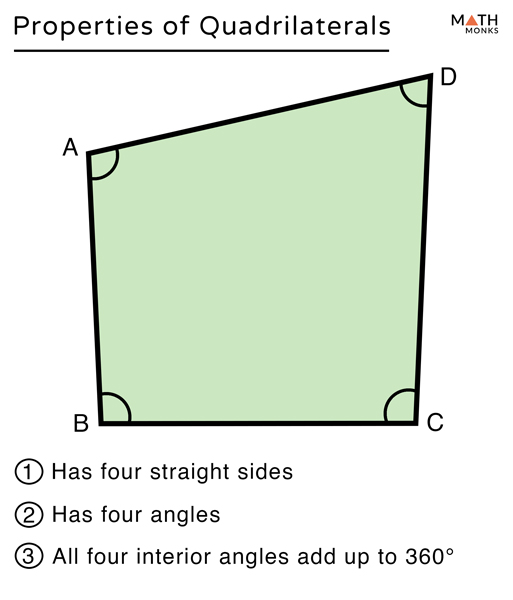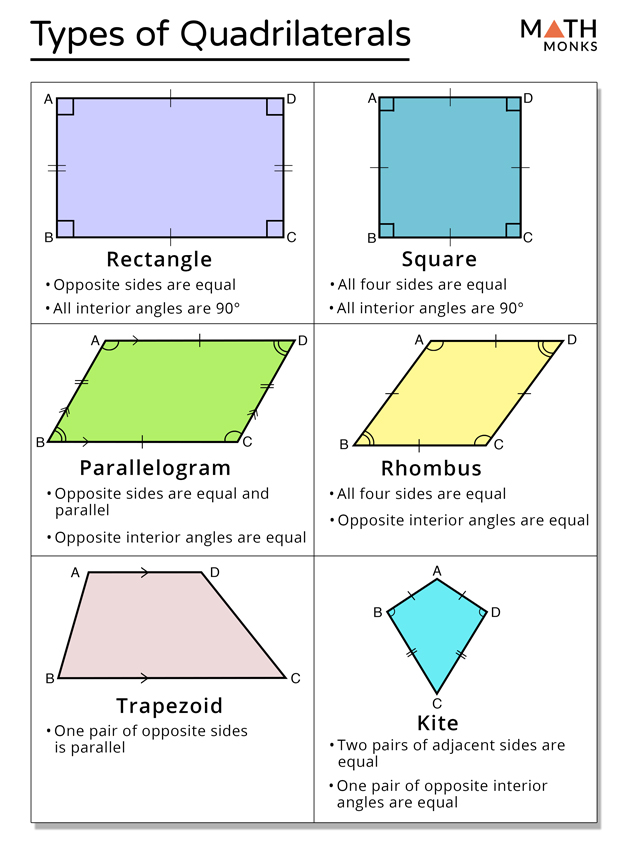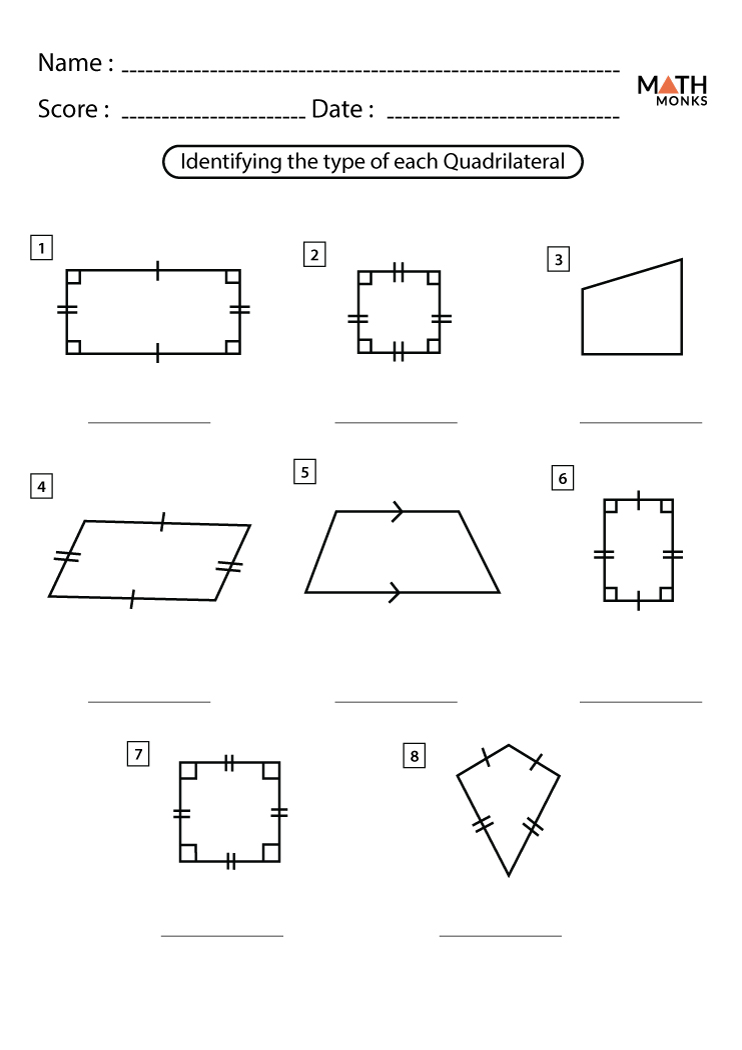A quadrilateral is a flat geometric shape having four straight sides and four vertices. It is a type of polygon.
The word ‘quadrilateral’ is derived from the Latin words ‘quadri’, meaning ‘four’, and ‘latus’, meaning ‘side’.
Quadrilateral Quadrilateral Angle Sides Has four straight sides; if ABCD is a quadrilateral, AB, BC, CD, and DA are the four sides Has four vertices creating four angles; points A, B, C and D are the four vertices creating angles ∠ABC, ∠BCD, ∠CDA, and ∠DAB All four interior angles add up to 360°; so ∠ABC+ ∠BCD + ∠CDA + ∠DAB = 360° In a quadrilateral ABCD, find ∠BCD, if ∠ABC = 80°, ∠CDA = 110°, and ∠DAB = 100°.
Solution:
As we know,∠ABC+ ∠BCD + ∠CDA + ∠DAB = 360° , here ∠ABC = 80°, ∠CDA = 110°, and ∠DAB = 100°
There are six basic types of quadrilaterals: 1) rectangle , 2) square , 3) parallelogram , 4) rhombus , 5) trapezoid , and 6) kite .
Each one of them and their basic properties are given below:
Special Quadrilateral Shapes Types 1) Based on Angles
a) Convex Quadrilateral
It is a type of quadrilateral with all its interior angles measuring less than 180°. A convex quadrilateral has both its diagonals inside the closed figure.
Square, rectangle, rhombus, and trapezoid are examples of a convex quadrilateral.
b) Concave Quadrilateral
It is a type of quadrilateral with at least one of its interior angles measuring greater than 180°. A concave quadrilateral has one of its diagonals outside the closed figure.
Dart or arrowhead is an example of concave quadrilateral.
2) Based on Side Lengths
a) Regular Quadrilateral
It is a type of quadrilateral with four sides of equal length and four angles of equal measure.
Square is the only regular quadrilateral.
b) Irregular Quadrilateral
It is a type of quadrilateral having one or more sides of unequal length and one or more angles of unequal measure.
Trapezoid and Kite are examples of irregular quadrilateral.
3) Based on the Presence of Intersecting Sides
a) Simple Quadrilateral
It is a type of quadrilateral with no self-intersecting sides. It can be either convex or concave.
Square, rectangle, and dart are some examples of simple quadrilateral.
b) Complex Quadrilateral
Also known as a crossed quadrilateral, it is a type of quadrilateral having self-intersecting sides. A complex quadrilateral is also known as a crossed quadrilateral, bow-tie quadrilateral, or butterfly quadrilateral.
Crossed trapezoid, crossed-square, and crossed-rectangle are some examples of complex quadrilateral.
Rectangle-shaped objects – Books, tabletops, mobile phones, and TV screens. Square-shaped objects – Chessboard, wall clock, and a slice of bread. Parallelogram-shaped objects – Street and traffic sign, the structures on the neck of a guitar, and the United States Postal Service logo. Rhombus-shaped objects – Section of a baseball field, mirrors, earrings, and rings. Trapezoid-shaped objects – Handbags, popcorn tins, guitar-like dulcimer, and truss bridge supports. Kite-shaped objects – A flying kite, wall hanging, and earrings. Q1. Is a trapezoid always a quadrilateral ?Ans . Yes, all trapezoids are quadrilaterals.
Q2. Are all parallelograms quadrilaterals? Ans . Yes, all parallelograms are quadrilaterals.
Q3. Is a kite always a quadrilateral? Ans . Yes, a kite is always a quadrilateral.
Q4. Are all quadrilaterals a polygon? Ans. Yes, quadrilaterals are a four-sided polygon.
Q5. Are all rectangles a quadrilateral? Ans . Yes, all rectangles are quadrilaterals.
Q6. Is every quadrilateral a rectangle? Ans . No, all quadrilaterals are not rectangles.
Q7. Are all quadrilaterals a square? Ans . No, all quadrilaterals are not squares.
Q8. Is a square always a quadrilateral? Ans. Yes, a square is always a quadrilateral.
Q9. Are all quadrilaterals a rhombus? Ans . No, every quadrilateral is not a rhombus.
Q10. Name the quadrilateral with exactly one pair of parallel sides. Ans . Trapezoid.
Q11. Name the quadrilateral with two pairs of opposite sides parallel .Ans . Parallelogram.
Q12. Name three quadrilaterals with no right angles .Ans . Parallelogram, rhombus and kite are three quadrilaterals with no right angles.
Q13. Name a quadrilateral with four right angles. Ans . Rectangle.
Q14. Name a quadrilateral with four congruent sides .Ans . Square.
Q15. Name a quadrilateral with only two right angles. Ans . Right trapezoid.
Q16. Name a quadrilateral that is equilateral but not equiangular. Ans . Rhombus.
Q17. Name a quadrilateral that is equiangular but not equilateral. Ans . Rectangle.
Q18. Name the quadrilaterals having diagonals perpendicular to each other. Ans . The quadrilaterals that have their diagonals perpendicular to each other are a square, a rhombus and a kite.
Q19. Which quadrilaterals have congruent diagonals? Ans . A square, an isosceles trapezoid, and a rectangle are quadrilaterals having congruent diagonals.
Q20. Is a diamond a quadrilateral? Ans . Yes, a diamond is a quadrilateral because it has four closed straight sides.





